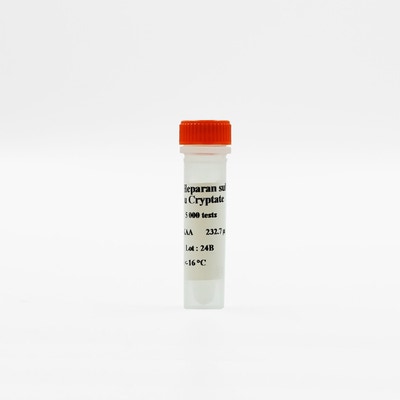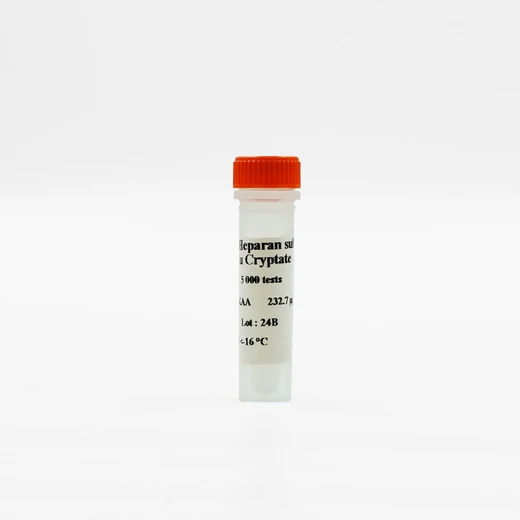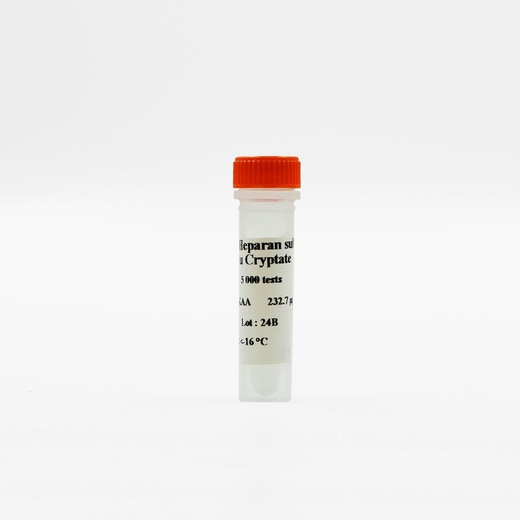

HTRF Biotin-Heparan sulfate-Eu cryptate reagent, 5,000 Assay Points


HTRF Biotin-Heparan sulfate-Eu cryptate reagent, 5,000 Assay Points






A proprietary heparan sulfate substrate labeled with both biotin and Eu3+ Cryptate to monitor heparanase activity.
For research use only. Not for use in diagnostic procedures.
| Feature | Specification |
|---|---|
| Application | Protein-Protein Interaction |
A proprietary heparan sulfate substrate labeled with both biotin and Eu3+ Cryptate to monitor heparanase activity.



HTRF Biotin-Heparan sulfate-Eu cryptate reagent, 5,000 Assay Points



HTRF Biotin-Heparan sulfate-Eu cryptate reagent, 5,000 Assay Points



Product information
Overview
HTRF heparan sulfate substrate labeled with both biotin and Eu3+ Cryptate used with HTRF SA-XL665, allows to monitor heparanase activity with the robustness of HTRF technology.
Heparanase is an enzyme that cleaves heparan sulfate, and thereby releases growth factors that are implicated in tumor cell proliferation, metastasis and angiogenesis.
Specifications
| Application |
Protein-Protein Interaction
|
|---|---|
| Brand |
HTRF
|
| Detection Modality |
HTRF
|
| Product Group |
Fluorescent Reagent
|
| Shipping Conditions |
Shipped in Dry Ice
|
| Target Class |
Binding Assay
|
| Technology |
TR-FRET
|
| Unit Size |
5,000 Assay Points
|
Video gallery

HTRF Biotin-Heparan sulfate-Eu cryptate reagent, 5,000 Assay Points

HTRF Biotin-Heparan sulfate-Eu cryptate reagent, 5,000 Assay Points

Citations
How it works
Assay principle
The HTRF heparanase assay is based on our proprietary heparan sulfate substrate, labeled with both biotin and Eu3+ Cryptate. Active heparanase enzyme cleaves the substrate causing the loss of energy transfer, and thus a reduction in SA-XL665 emissions.

Assay protocol
The assay is run as a two-step process: 1.Heparanase enzymatic reaction: Mix together, the substrate, the heparanase and/or compounds, incubate for 30 min at 37°C (We recommend a time course study to determine the optimal stimulation time) 2.Heparanase activity detection: Add Streptavidin-XL665.

Assay validation
Heparanase assay: enzymatic kinetic
HTRF Heparanase assay was performed using a range of enzyme concentrations. The heparanase enzyme reaction was allowed to proceed for various times prior to adding SA-XL665 and the emissions detected. The effects of heparanase enzyme concentration and the enzyme reaction time on substrate degradation are shown here. Based on the linearity of the enzyme dose-response, enzyme consumption and incubation time results, 90 ng/mL of heparanase incubated for 30 minutes at 37ºC was chosen for inhibitor screening.

Heparanase assay: inhibitory effect of suramin
Heparanase assay was performed using a range of enzyme concentrations with a final assay volume of 20 µL. Then an inhition assay was performed using heparanase at 90ng/mL incubated for 30 minutes at RT in presence of various concentrations of Suramin.
Fig A shows the Heparanase assay standard curve, assay CVs were lower than 3%. Fig.B shows the inhibitory effect of Suramin, a known inhibitor of heparanases. The IC50 was calculated at 4 µM, which is in agreement with values calculated using radiometric methods (1-10µM).


Resources
Are you looking for resources, click on the resource type to explore further.
Discover the versatility and precision of Homogeneous Time-Resolved Fluorescence (HTRF) technology. Our HTRF portfolio offers a...
This guide provides you an overview of HTRF applications in several therapeutic areas.
SDS, COAs, Manuals and more
Are you looking for technical documents related to the product? We have categorized them in dedicated sections below. Explore now.
-
LanguageEnglishCountryUnited States
-
LanguageFrenchCountryFrance
-
LanguageGermanCountryGermany
-
LanguageGreekCountryGreece
-
LanguageItalianCountryItaly
-
LanguageSpanishCountrySpain
-
LanguageEnglishCountryUnited Kingdom
-
Lot number25RCLot dateJuly 22, 2028
-
Lot number25RBLot dateJuly 22, 2028
-
Lot number25BLot dateJuly 22, 2028
-
Lot number26ALot dateJanuary 26, 2034
-
Lot number25RBLot dateJuly 22, 2028
-
Lot number25ALot dateJuly 22, 2028
-
Lot number25RCLot dateJuly 22, 2028
-
Lot number25BLot dateJuly 22, 2028
-
Lot number24BLot dateOctober 17, 2026
-
Lot number24ALot dateOctober 17, 2026
-
Lot number23CLot dateFebruary 22, 2026
-
Lot number23BLot dateFebruary 22, 2026
-
Lot number23ALot dateFebruary 22, 2026


How can we help you?
We are here to answer your questions.






























